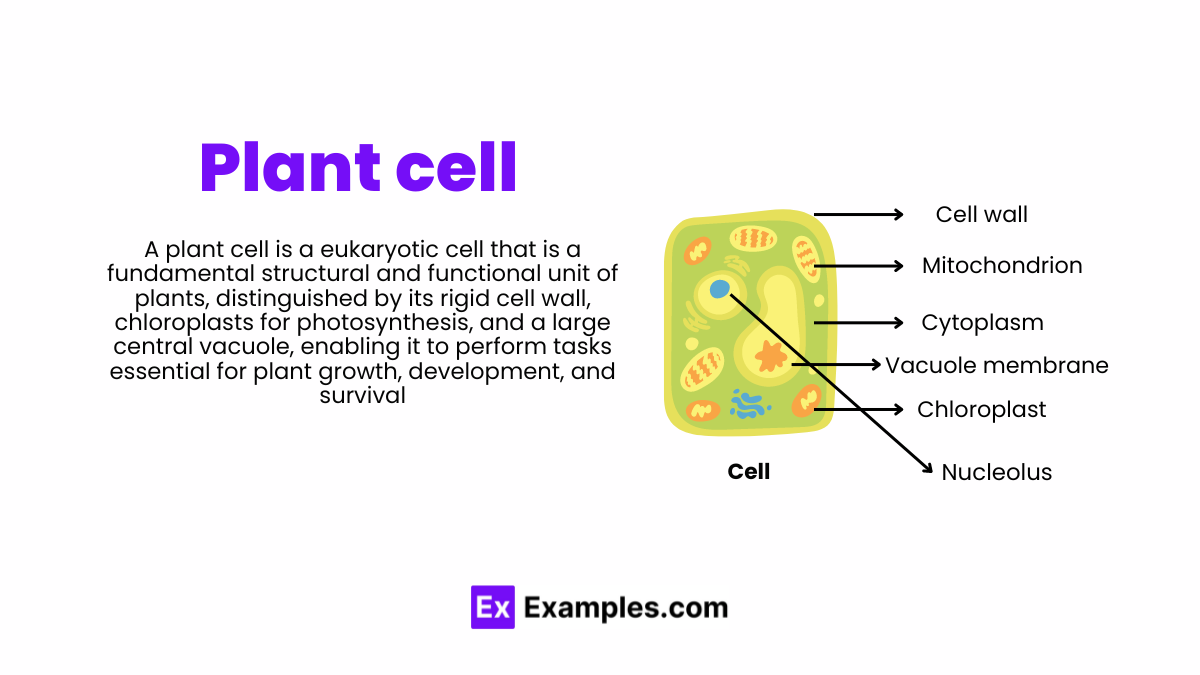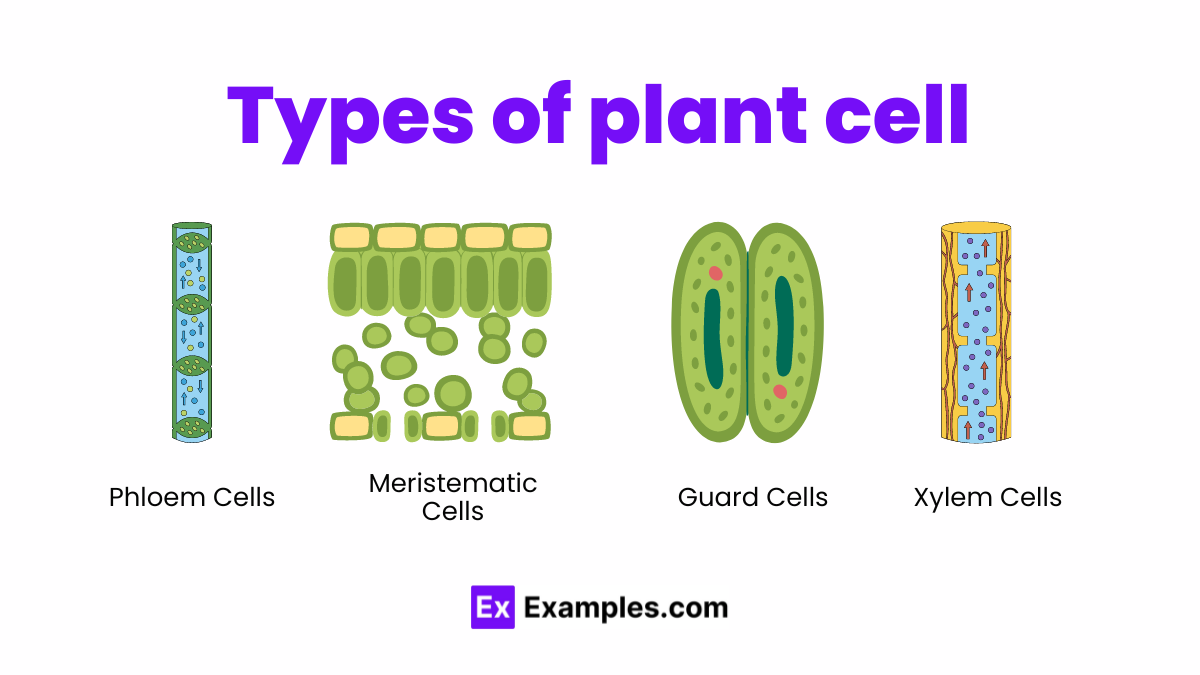Which of the following structures is found only in plant cells and not in animal cells?
Nucleus
Mitochondria
Cell wall
Ribosomes

Plant cells are the basic unit of life in all plant species. They belong to the eukaryotic family, which means they have a well-defined, membrane-bound nucleus, much like animal cells. But what sets plant cells apart are their distinctive structures and functions, tailor-made to support life in various environments.
What is a Plant Cell?
A plant cell is essentially a miniature processing unit within a plant, protected by a robust outer shell known as the cell wall that provides structure and support. Inside this tiny powerhouse, various components each play a critical role. It houses chloroplasts, akin to mini power stations, that harness sunlight and convert it into energy through a process involving a green pigment known as chlorophyll. Additionally, a large compartment called a vacuole acts as a reservoir, storing essential water and nutrients, contributing to the plant’s vitality and rigidity. Together, these elements enable the plant to thrive, synthesize food, and maintain its health.
A plant cell is like a tiny, self-contained city, wrapped in a sturdy wall made of cellulose that keeps it safe and maintains its shape. Inside, it has special green rooms called chloroplasts, where sunlight is turned into energy, thanks to a magic green pigment called chlorophyll. It’s also got a big storage area called a vacuole, filled with a mix of water, salts, and sugars, which helps the plant stay plump and upright. All these parts work together to help the plant grow and stay healthy, making plant cells unique and fascinating building blocks of all plant life.
Unique to plant cells, the cell wall surrounds the cell membrane, providing structure, support, and protection. Made primarily of cellulose, it ensures the cell maintains its shape, protects against mechanical stress, and regulates water intake. The cell wall is crucial for the overall integrity and functionality of plant cells.
Beneath the cell wall lies the cell membrane, a phospholipid bilayer that controls the movement of substances in and out of the cell. This selective permeability is vital for maintaining the cell’s internal environment, allowing essential nutrients to enter while keeping unwanted substances out.
The cytoplasm is the gel-like substance that fills the interior of the cell, providing a medium for biochemical reactions. It contains all organelles, except for the nucleus, and plays a critical role in cell expansion, growth, and replication.
The nucleus, often referred to as the cell’s control center, houses the cell’s genetic material (DNA). It controls all cellular activities by regulating gene expression and coordinating cell growth, division, and differentiation.
Chloroplasts are the distinguishing organelles of plant cells, responsible for photosynthesis. They contain the green pigment chlorophyll, which captures light energy to convert carbon dioxide and water into glucose and oxygen, a process essential for plant growth and the basis of life on Earth.
Mitochondria are involved in cellular respiration, a process that converts the energy stored in glucose into ATP (adenosine triphosphate), the cell’s energy currency. Despite plants having chloroplasts, mitochondria play a crucial role in energy production, especially in non-photosynthetic cells.
A plant cell typically contains a large central vacuole, which serves multiple functions, including storing nutrients and waste products, providing structural support, and playing a role in plant growth by absorbing water and expanding.
The endoplasmic reticulum (ER) is a network of membranes involved in protein and lipid synthesis. The rough ER, studded with ribosomes, synthesizes proteins, while the smooth ER is involved in lipid production. The Golgi apparatus modifies, sorts, and packages proteins and lipids for delivery to their destinations within or outside the cell.
Ribosomes are the sites of protein synthesis, where RNA is translated into proteins. These small structures can be found floating freely in the cytoplasm or attached to the rough ER.
In the intricate world of botany, understanding the different types of plant cells is crucial for a comprehensive grasp of plant structure and function. Plant cells can be broadly categorized based on their roles and characteristics, contributing to the plant’s overall health, growth, and reproduction. This guide is tailored to offer a detailed explanation of plant cell types, optimized for those seeking insights into “plant cell types explain briefly.”
Parenchyma cells are the most common type of plant cells, known for their versatile functions. These cells are involved in photosynthesis, storage, and tissue repair, making them fundamental to plant growth and regeneration. Characterized by their thin cell walls and large vacuoles, parenchyma cells can be found throughout the plant.
Collenchyma cells provide structural support to the plant, especially in areas of growth such as the stems and leaves. They are flexible, allowing the plant to withstand external pressures like wind and mechanical stress. Collenchyma cells are identifiable by their unevenly thickened cell walls, which are composed mainly of pectin and cellulose.
Sclerenchyma cells are the plant’s protectors, providing rigidity and strength to withstand various stresses. These cells have thick, lignified cell walls, making them hard and impermeable. There are two main types of sclerenchyma cells: fibers, which contribute to the plant’s structural support, and sclereids, which add strength to nutshells and seed coats.

Xylem cells specialize in transporting water and minerals from the roots to the rest of the plant. These cells are part of the xylem tissue and are characterized by their ability to form long tubes that efficiently conduct water. The primary types of xylem cells are tracheids and vessel elements, both of which are key to the plant’s vascular system.
Phloem cells are responsible for transporting sugars and other organic nutrients produced during photosynthesis to non-photosynthetic parts of the plant. Phloem tissue consists of sieve-tube elements and companion cells, working together to ensure the distribution of nutrients is both efficient and effective.
Guard cells play a crucial role in regulating gas exchange and water loss through stomata, the tiny openings on the surface of leaves and stems. These cells can change shape to open or close the stomata, balancing the plant’s need for carbon dioxide for photosynthesis with the prevention of excessive water loss.
Meristematic cells are found in the plant’s meristems, where active growth occurs. These cells are capable of continuous division, contributing to the plant’s growth in length (apical meristems) and girth (lateral meristems). Meristematic cells differentiate into various specialized cells, driving the development of new tissues and organs.
Plant cells, with their unique structures and organelles, perform a myriad of functions vital to the growth, survival, and reproduction of plants. Understanding these functions is essential for anyone looking to delve deeper into plant biology and ecology. This guide aims to provide a detailed, SEO and NLP-friendly exploration of plant cell functions, optimized for the query “plant cell functions.”
Photosynthesis is arguably the most crucial function performed by plant cells, specifically within the chloroplasts. This process involves converting light energy into chemical energy, producing oxygen and glucose from carbon dioxide and water. Photosynthesis not only fuels the plant’s own growth but also supports the entire ecosystem by providing the primary energy source for other organisms.
While photosynthesis stores energy, respiration is the process of converting this stored energy into a form that can be used for various cellular activities. Mitochondria play a central role in respiration, breaking down glucose molecules to produce ATP (adenosine triphosphate), the energy currency of the cell.
The cell wall, unique to plant cells, provides structural support and maintains the cell’s shape. It also protects against mechanical stress and regulates the movement of water through osmosis, contributing to the plant’s overall rigidity and stability.
Plant cells are integral to the plant’s vascular system, which includes the xylem and phloem tissues. Xylem cells transport water and minerals from the roots to the rest of the plant, while phloem cells distribute the sugars produced during photosynthesis. This coordinated transport system is vital for the plant’s nourishment and growth.
Plant growth and reproduction depend on the cell’s ability to divide and differentiate. Meristematic cells, located in specific regions of the plant, are capable of continuous division, leading to new cells that can specialize into various types of plant tissues, contributing to both the growth and repair of the plant.
Many plant cells are specialized to store nutrients, water, and energy reserves in the form of starch, fats, and oils. These storage cells ensure the plant’s survival during adverse conditions, providing the necessary resources for growth and reproduction when favorable conditions return.
Plant cells also play a critical role in the plant’s defense against pathogens and pests. The cell wall acts as a physical barrier, while other cells can produce toxins or signaling molecules that activate the plant’s immune response, helping to ward off infections and infestations.
Plant cells communicate with each other through signaling molecules, coordinating responses to environmental changes, stress, and developmental cues. This cellular communication is essential for the plant’s adaptation and survival in varying environmental conditions.
A plant cell is the basic structural and functional unit of plants, characterized by a cell wall, chloroplasts, and a large vacuole, enabling photosynthesis and growth.
Plant cells differ from animal cells by having a cell wall, chloroplasts for photosynthesis, and a large central vacuole, which are absent in animal cells.
Chloroplasts in plant cells capture light energy to perform photosynthesis, converting carbon dioxide and water into oxygen and glucose, fueling plant growth.
The cell wall provides structural support, protection, and rigidity to plant cells, helping maintain shape and resist mechanical stress while regulating water intake.
Yes, plant cells can repair themselves. Meristematic cells in plants have the ability to divide and differentiate, aiding in growth and repairing damaged tissues.
Text prompt
Add Tone
What is a Plant Cell?
Plant Cell Types
Which of the following structures is found only in plant cells and not in animal cells?
Nucleus
Mitochondria
Cell wall
Ribosomes
What is the primary function of chloroplasts in plant cells?
Respiration
Protein synthesis
Photosynthesis
Reproduction
The large central vacuole in plant cells is mainly responsible for:
Storing genetic information
Synthesizing proteins
Storing water and maintaining cell pressure
Conducting photosynthesis
Which of the following organelles contains the green pigment chlorophyll?
Chloroplast
Nucleus
Mitochondria
Golgi apparatus
In plant cells, the rigid structure that provides support and protection is called the:
Cell membrane
Cell wall
Cytoplasm
Endoplasmic reticulum
What is the role of the plasmodesmata in plant cells?
Transporting proteins
Conducting photosynthesis
Synthesizing lipids
Facilitating communication between cells
Where does the process of photosynthesis primarily occur in plant cells?
Mitochondria
Ribosomes
Chloroplasts
Nucleus
Which part of the plant cell is responsible for storing starch?
Chloroplast
Amyloplast
Mitochondria
Golgi apparatus
The plant cell structure responsible for modifying, sorting, and packaging proteins is the:
Golgi apparatus
Endoplasmic reticulum
Ribosome
Lysosome
Which component of the plant cell helps in the formation of the cell plate during cell division?
Centrioles
Chloroplasts
Microtubules
Cell wall
Before you leave, take our quick quiz to enhance your learning!

